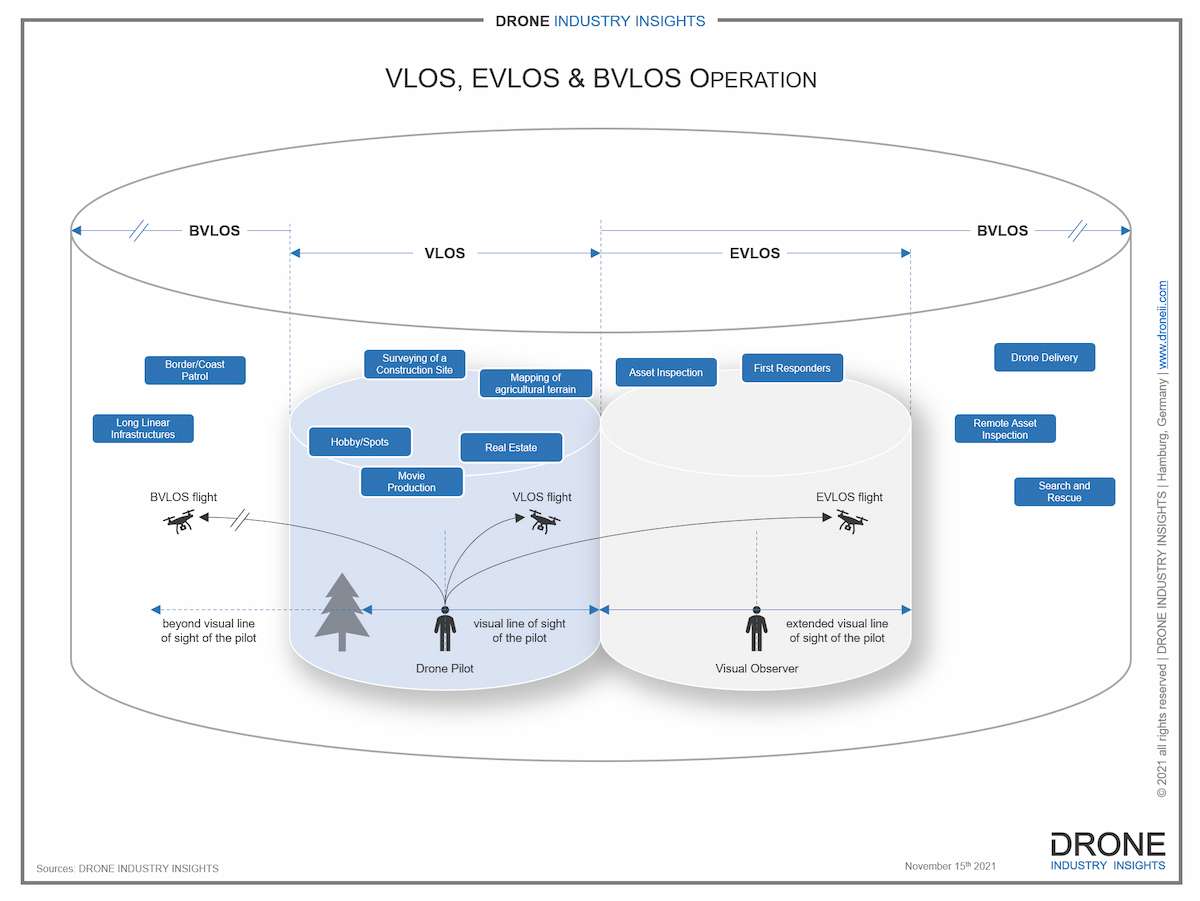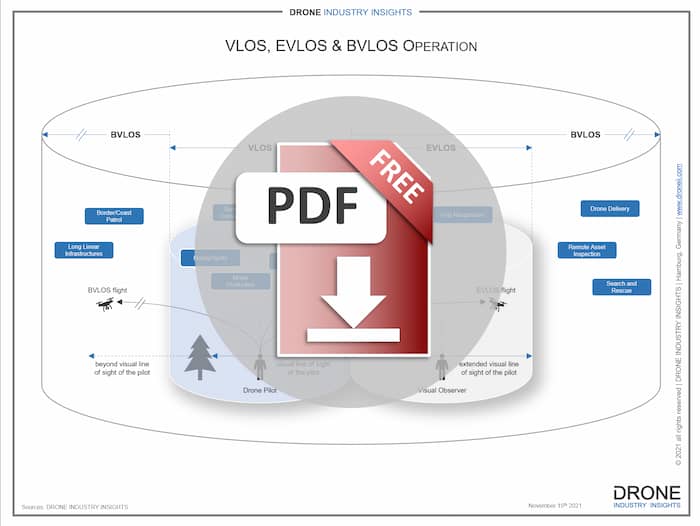BVLOS Operations: Expanding the Frontier
Everyone in the drone industry is familiar with the term “BVLOS Operations”. And yet despite articles about the past, present and future of this topic, drone flights beyond-visual-line-of-sight have remained limited due to regulation. In some ways, it’s as if the entire industry is holding its collective breath for regulations to be approved and take effect so that widespread BVLOS operations can officially get off the ground. But developments such as the FAA’s establishment of a “UAS BVLOS ARC Charter” in June 2021 suggest that BVLOS flights will finally become more regular soon, so we want to re-visit the topic of why and how companies should leverage BVLOS operations.
How BVLOS Operations differ from VLOS and EVLOS
In VLOS (visual line of sight) operations, the distance a drone can travel from the pilot is typically limited to about 500m (and many aviation authorities set this as the maximum on regulations). This means that if a pilot wants to expand operation beyond this limit, the drone, the pilot and all equipment have to constantly be moved to a new location to continue operation in another 500m radius. Typical VLOS drone applications take place in the vicinity of a pilot – e.g. wind turbine inspection, mapping of a construction site, aerial footage for real estate, or movie productions. But for some businesses such as drone delivery this is not just inefficient, it makes drone operation practically impossible.
EVLOS (extended visual line of sight) operation increases the operational radius of a drone by using a visual observer as an extra pair of eyes. Connected via radio/phone, the observer can alert the pilot whenever necessary. Although this expands the operational radius, it also requires more manpower and logistical effort. Scaling drone operation under EVLOS conditions requires a proportionally growing team of observers which once again creates an issue of efficient use of resources.
To unlock the full economic potential of commercial drone operations, flights must be operated beyond the visual line of sight (BVLOS). This allows drones to simply accomplish more in a single flight and ultimately allows operators to benefit from long-distance drone operation, providing a maximum of cost-effectiveness. Among others, BLVOS operations include flying behind buildings in urban areas, transporting goods from the shore to an offshore oil rig, or remote operation from a different country thousands of kilometers away. Once regulations take effect to allow for widespread BVLOS operations, companies will be able to leverage drone potential to its fullest.
Leveraging BVLOS Operations
Economically leveraging drone operation means using all the capabilities of a pre-programmed flying robot. To qualify leverage for today and the future, it is important to distinguish between different modes of operation. While in some cases a pilot is and will remain necessary (e.g. the active search for damages during inspection), making the human-in-the-loop obsolete will increase the overall efficiency of drone operation even more. So, to highlight how much impact BVLOS operations can have on the use of drone technology, let’s make use of an analogy.
In the same way that a washing machine can replace manual washing, a drone can replace delivery by a person. The first step for both the drone delivery and the washing machine would still require manual operation of the device by a person. “VLOS operation” would entail a person monitoring speed and temperature of the wash (or the flight of the drone), and actively controlling the sequence from pre-wash to wash to spin cycle (or the flight path from A to B to C). Meanwhile “BVLOS operation” would mean that the person can sit away from the machine/drone without looking at it, but still has to actively control the entire process.
“VLOS-on-waypoints” operation would be equivalent to a pre-programmed wash or flight, yet the person still has to be present and visually monitor each sequence to ensure that everything works properly. “BVLOS on waypoints” would entail monitoring the process from afar but being able to intervene if necessary. The highest level of replacement would be “BVLOS and fully automated“, meaning that the process starts and stops by itself without any input from an operator. This is what most of us are currently used to in terms of washing machines, and this is what an ideal drone delivery would look like, but we are not there yet on the latter case. Full automation and safely taking human operators out of the equation will allow for the most productivity and profitability of using drones for all types of business applications.
Of course, this oversimplification still has some issues. The first issue is that drone automation, operation and airspace integration are a lot more complex than using a washing machine at home. Even though many industry players correctly claim that their solutions are technically capable of operating fully-autonomously, a lot of regulatory and liability questions are still unanswered. In the “BVLOS on waypoints” scenario, the operator-in-charge is fully liable for any accident, even if s/he might sit in a different country while operating the drone. And at this point there is also no regulatory framework for “BVLOS and full automation” on the horizon, though it is likely that a waiver-based or risk-based approach will eventually allow for this kind of operation.
Want to Know More About the BVLOS Operations? Check Out Our New Report!
Report | BVLOS Operations 2021
• Extensive 84-page BVLOS Operations Report with in-depth analysis, industry definitions, & 5-year forecast.
• Dedicated chapters for BVLOS Connectivity (WiFi, 4G5G, SATCOM) and Risk Mitigation as well as on BVLOS Regulation
• Analysis of BVLOS Application potential for 17 industry verticals as well as breakdown of BVLOS Market Sizes (Urban & Rural as well as per region and by unit sales)
Technical Limitations of BVLOS Operations
Aside from weather and other operational constraints, what are some technical limitations of BVLOS operations and how can they be overcome? Here are three of the more prominent examples as well as some potential solutions.
Flight time: Naturally, a drone has a limited battery life. Yet this can be overcome by using the right drone for the right task. Instead of using a multirotor drone for long distances, a fixed-wing drone might collect data just as well and flies more efficiently (by a factor eight). Another solution is to place charging pads along a linear infrastructure or at neuralgic points to re-charge the drone. And yet another possible solution is to place a drone base station at the target location.
Sensor data: Data storage and data transmission is not a BVLOS-specific issue but rather an issue that will be amplified in BVLOS operations. The longer the flight, the more data can be collected. Two ways to overcome this issue are: 1. downloading all the data while the drone is re-charging in a drone base station and sending it to an operation center via land line or 2. stream the data to the operation center via cellular network (4G/5G).
Performance: Complex technical systems can have malfunctions. This may start with a dirty lens on the sensors but can extend to excessive power consumption, decreasing battery capacity or other technical issues like wear, damage through physical force, short circuits etc. These issues are hard to solve without physically going there to fix them, especially in scenarios where drone operation is performed far from the operator (e.g. off-shore wind farm). One solution is a constant performance-monitoring (preventive & predictive maintenance), which can check if all systems are 100% intact and monitor the drones’ condition over time. This allows potential issues to be fixed in routine maintenance intervals before they have an impact on the drone operation.
Conclusion
With all of this in mind, it is no surprise that the industry as a whole has been anticipating the day when BVLOS operations can be carried out with less limitations. By allowing companies to leverage the use of BVLOS at a higher level of automation, drone technology will finally unleash its disruptive potential. Processes will be quicker and more efficient; data will be acquired at higher quality while keeping workers out of harm’s way and all of this will carry a much smaller ecological footprint. This is precisely why so many have been looking forward to the rise of BVLOS and why expanding the frontier will be a substantial boost to the global drone industry.
For more information on the projected impact per industry vertical and per region, check out the full BVLOS Operations Report.
Download our FREE BVLOS Definition Infographic
This infographic, “BVLOS Definition”, shows the difference between VLOS, ELOS, and BVLOS flights in relation to where a drone operator is located.

Before working with drones, Ed acquired vast experience in Communications and Diplomacy. He holds a Master’s in International Relations, Bachelor’s in Economics & Philosophy, and has lived in 7 countries.





